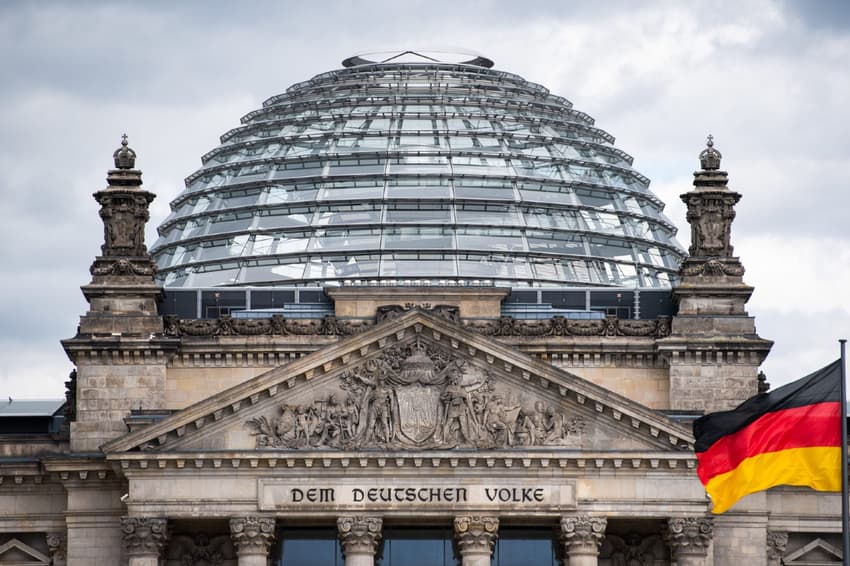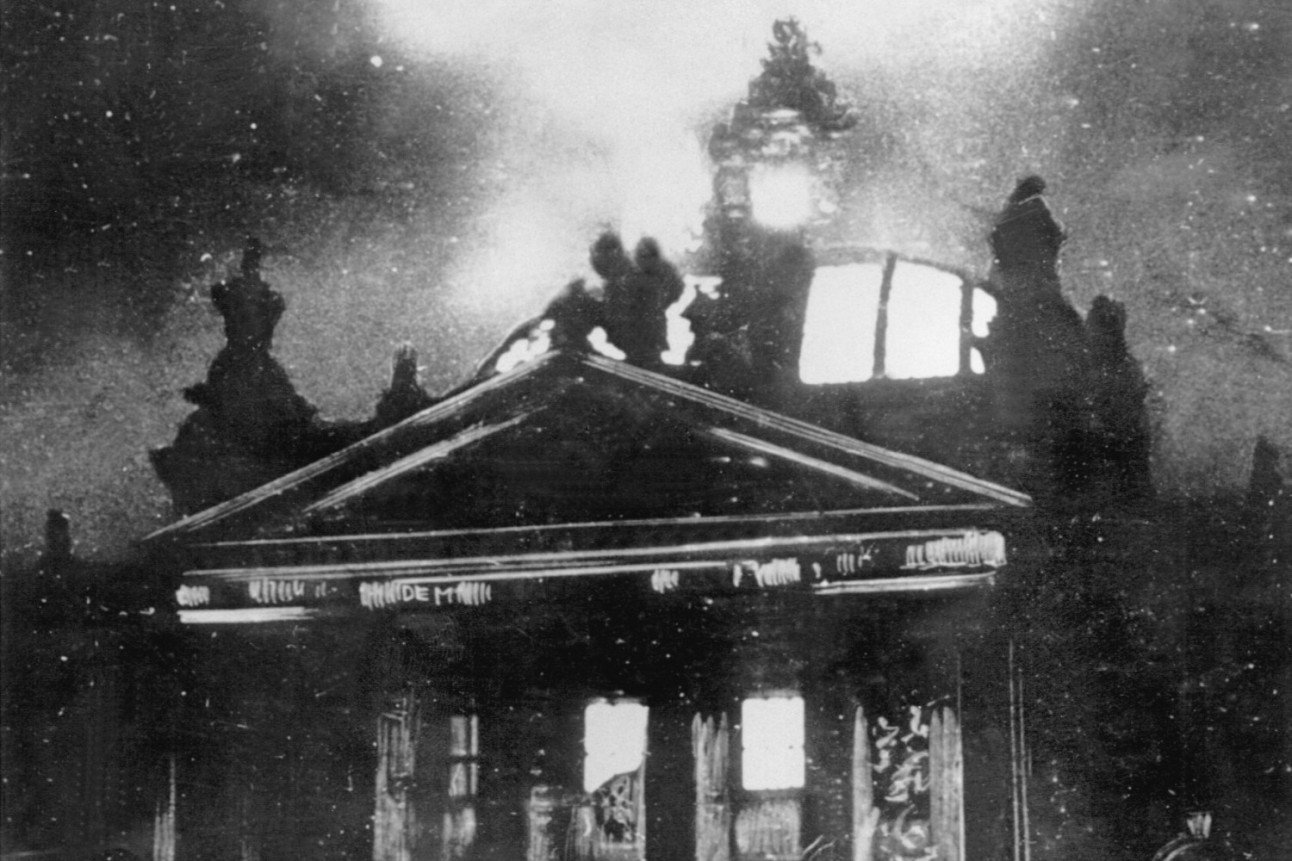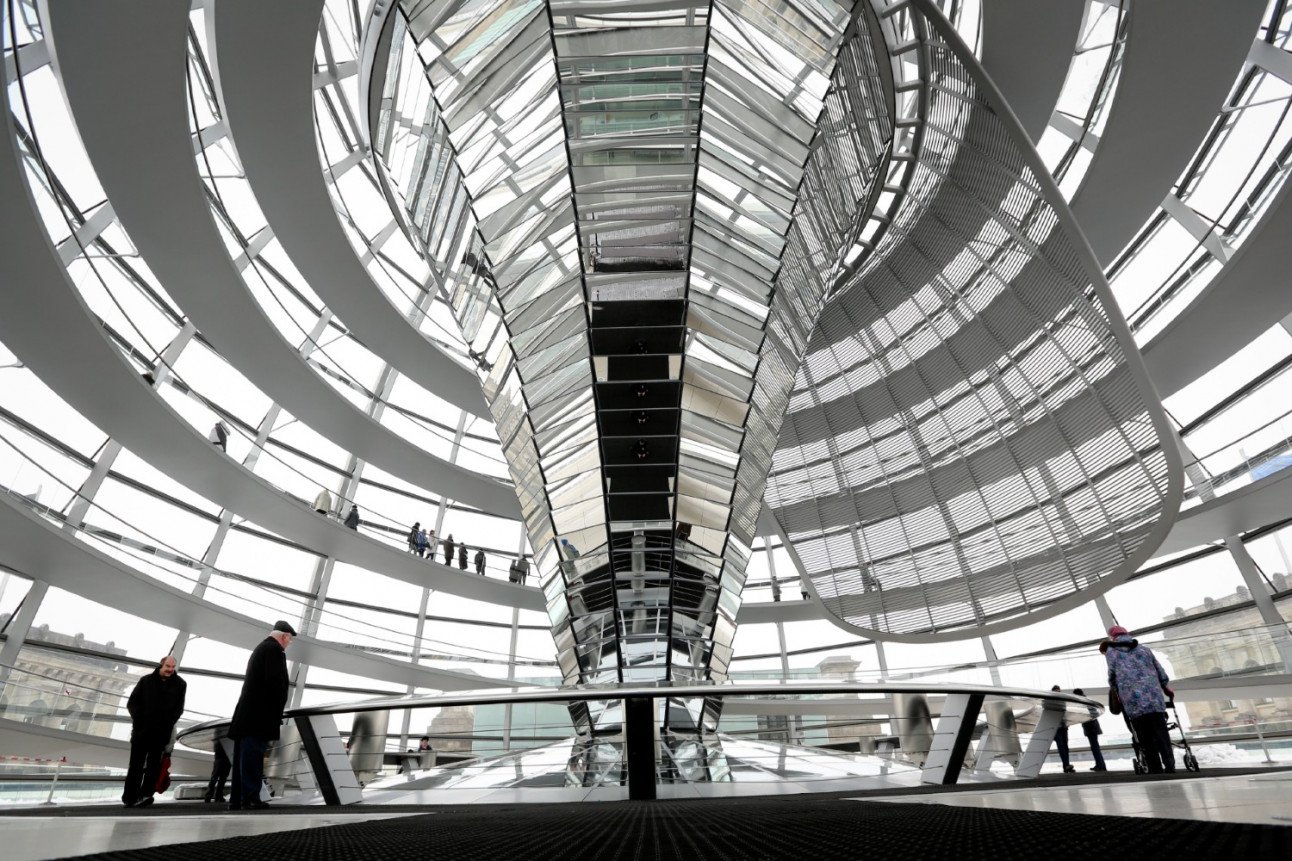'To the German people': What is the history behind Berlin’s iconic Reichstag?

“The heart of democracy beats here, or it does not beat at all”: Germany’s Reichstag is known today as one of the most iconic parts of the German capital’s cityscape. But why is the building so important, and how did it become the symbol of civil liberty it is today?
The Reichstagsgebäude (Reichstag building), which sits at the height of Berlin’s Regierungsviertel (Government District), is the current home of the German Bundestag (Parliament).
Nowadays, it is widely regarded as a symbol of open democracy and welcomes over three million visitors from across the globe each year.
This status, however, was hard-won. Since it first opened its doors, the building has borne witness to 130 years of Germany’s turbulent history, the traces of which can be still seen in the building’s architecture today.
It was in the spotlight this weekend as anti-coronavirus protesters tried to storm it, an incident which Germany quickly decried as an attack on democracy.
READ ALSO: Germany slams 'unacceptable' attempt to storm Reichstag
Early beginnings
Following the unification of Germany and the establishment of the German Reich (German Empire) in 1871, the need arose for a building to house the newly formed Reichstag (Imperial Diet).
After ten years of land disputes and delays, the foundation stone for the Reichstag building was finally laid on Königsplatz (King’s Square) on June 20th 1884.
The Kaiser did not live to see the building’s opening in 1894, however, and his successor did not take so warmly to the concept of parliamentary democracy.
In fact, Kaiser Wilhelm II was so opposed to the notion that he initially fought against the words chosen for the main facade of the building. His suggestion, Der Deutschen Einigkeit (To German Unity), was soundly rejected by his parliament, who voted instead for the now-iconic inscription Dem Deutschen Volke (To the German People).
But the days of the Imperial Diet, much like those of the Empire, were numbered. In 1918, Germany’s defeat in the First World War led to revolution and paved the way for the collapse of the monarchy.
A fragile democracy
Shortly after the Kaiser declared his resignation, politician Philip Scheidemann appeared on one the balcony of the Reichstag, triumphantly declaring the birth of the Weimar Republic.
For the first time, the building found itself home to a truly democratic parliament, free from the constraints of monarchical power and elected by the people of Germany.
The country enjoyed relative stability during the Golden Twenties as the economy flourished and political tensions subsided.
However, the worldwide financial crash of 1929 and the subsequent economic crisis proved fatal for the fragile Republic, leading to mass unemployment, spiralling hyperinflation and unworkable political divisions in parliament.
The NSDAP (Nazi Party), on the other hand, saw the crisis as an ideal opportunity. Profiting from widespread discontent, the party went from just twelve seats in the Reichstag in 1928 to 196 in November of 1932.
Its leader, Adolf Hitler, became Chancellor in January of 1933, and just one month later the Reichstag Building was engulfed in flames.

The Reichstag building in flames in February 1933. Photo: Ullstein
The exact cause of the fire remains unknown, but the Nazis used the incident as a spring board to arrest communist opposition and suspend civil rights across Germany.
Shortly after, under great intimidation from Nazi security forces, the Weimar parliament passed the Enabling Act of 1933, signing away its own power and marking the effective end of democracy in the country.
From one dictatorship to another
Although the building was scarcely used during the Nazi dictatorship, it was viewed by the allied powers in the Second World War as a symbol of the fascist enemy they were determined to defeat.
In early May 1945, after days of fighting in the capital, Russian troops closed in on the Reichstag and planted their flag on its roof, marking the end of Nazi rule.
Visitors to the building today can still see the graffiti left by allied soldiers and bullet holes caused by the fighting on sections of wall preserved in the building’s reconstruction.
After the war and the subsequent division of Germany, the Reichstag lay in ruin and disuse. It was provisionally restored in 1954 but was used only for occasional meetings and cultural exhibitions.
The West German parliament relocated to Bonn, the new capital of the Federal Republic of Germany, whilst the East German Volkskammer (effectively a rubber-stamp parliament) sat in the nearby Palast der Republik (Palace of the Republic).
As tensions between East and West grew and the Berlin Wall was erected in 1961, the politically-significant Reichstag lay too close to the border to be able to serve any purpose.
Nevertheless, it remained the stage for many of the historically defining events of the Cold War. West Berlin mayor Ernst Reuter stood in front of the building to plead for help during the Berlin Blockade in 1948-49, and singer David Bowie used it as a backdrop for a protest concert demanding the fall of the Berlin Wall in 1987.

Huge crowds gathered to celebrate the reunification of Germany. Photo: DPA
A new chapter
This demand became a reality just two years later, paving the way for the end of decades of division.
In March 1990, East Germany held its first free and fair election and in October of the same year, hundreds of thousands gathered in front of the Reichstag to celebrate the reunification of Germany.
It was decided that the German parliament should move back to the Reichstag building in Berlin, which became the country’s capital city once more.
Architects from across the world submitted their plans for the redesign of the Reichstag, but it was British architect Norman Foster that was ultimately tasked with the restoration project.
In the lead-up to the building’s reopening in 1995, artists Jeanne-Claude and Christo wrapped the Reichstag in 100,000 square meters of silver fabric to symbolise the beginning of a new chapter in Germany’s history.
Symbolic Architecture
Today, the building boasts an internationally renowned dome, made with transparent, energy-efficient glass that allows German citizens to (quite literally) watch over their democratically elected representatives.

The Reichstag's iconic glass dome has become a worldwide symbol for open democracy. Photo: DPA
Foster also ensured that the building’s history remained part of its architecture, preserving elements of the building that remind visitors of Germany’s difficult road to democracy.
In the basement, visitors will find the “Archive of German Members of Parliament”, which is home to around 5,000 boxes remembering every democratically elected politician between 1919 and 1999.
Visitors will also find multiple black boxes representing the schwarze Jahre (black years) of Germany’s political history, with one box for each year that the German people spent without a democratically elected governing body.
Germany’s open democracy is not just represented in the building’s architecture, however: every year on the Tag der Ein- und Ausblicke (Open Door Day), the building opens its doors to the people and offers them a detailed insight into the workings of parliament.
Since its reopening in 1999, the Reichstag has become the most visited parliament building in the world. Few other buildings pay greater tribute to the importance of democracy for German citizens today.
For many, the Reichstag is testament to Germany’s desire to look hopefully into the future whilst also remembering its past.
Comments
See Also
The Reichstagsgebäude (Reichstag building), which sits at the height of Berlin’s Regierungsviertel (Government District), is the current home of the German Bundestag (Parliament).
Nowadays, it is widely regarded as a symbol of open democracy and welcomes over three million visitors from across the globe each year.
This status, however, was hard-won. Since it first opened its doors, the building has borne witness to 130 years of Germany’s turbulent history, the traces of which can be still seen in the building’s architecture today.
It was in the spotlight this weekend as anti-coronavirus protesters tried to storm it, an incident which Germany quickly decried as an attack on democracy.
READ ALSO: Germany slams 'unacceptable' attempt to storm Reichstag
Early beginnings
Following the unification of Germany and the establishment of the German Reich (German Empire) in 1871, the need arose for a building to house the newly formed Reichstag (Imperial Diet).
After ten years of land disputes and delays, the foundation stone for the Reichstag building was finally laid on Königsplatz (King’s Square) on June 20th 1884.
The Kaiser did not live to see the building’s opening in 1894, however, and his successor did not take so warmly to the concept of parliamentary democracy.
In fact, Kaiser Wilhelm II was so opposed to the notion that he initially fought against the words chosen for the main facade of the building. His suggestion, Der Deutschen Einigkeit (To German Unity), was soundly rejected by his parliament, who voted instead for the now-iconic inscription Dem Deutschen Volke (To the German People).
But the days of the Imperial Diet, much like those of the Empire, were numbered. In 1918, Germany’s defeat in the First World War led to revolution and paved the way for the collapse of the monarchy.
A fragile democracy
Shortly after the Kaiser declared his resignation, politician Philip Scheidemann appeared on one the balcony of the Reichstag, triumphantly declaring the birth of the Weimar Republic.
For the first time, the building found itself home to a truly democratic parliament, free from the constraints of monarchical power and elected by the people of Germany.
The country enjoyed relative stability during the Golden Twenties as the economy flourished and political tensions subsided.
However, the worldwide financial crash of 1929 and the subsequent economic crisis proved fatal for the fragile Republic, leading to mass unemployment, spiralling hyperinflation and unworkable political divisions in parliament.
The NSDAP (Nazi Party), on the other hand, saw the crisis as an ideal opportunity. Profiting from widespread discontent, the party went from just twelve seats in the Reichstag in 1928 to 196 in November of 1932.
Its leader, Adolf Hitler, became Chancellor in January of 1933, and just one month later the Reichstag Building was engulfed in flames.

The Reichstag building in flames in February 1933. Photo: Ullstein
The exact cause of the fire remains unknown, but the Nazis used the incident as a spring board to arrest communist opposition and suspend civil rights across Germany.
Shortly after, under great intimidation from Nazi security forces, the Weimar parliament passed the Enabling Act of 1933, signing away its own power and marking the effective end of democracy in the country.
From one dictatorship to another
Although the building was scarcely used during the Nazi dictatorship, it was viewed by the allied powers in the Second World War as a symbol of the fascist enemy they were determined to defeat.
In early May 1945, after days of fighting in the capital, Russian troops closed in on the Reichstag and planted their flag on its roof, marking the end of Nazi rule.
Visitors to the building today can still see the graffiti left by allied soldiers and bullet holes caused by the fighting on sections of wall preserved in the building’s reconstruction.
After the war and the subsequent division of Germany, the Reichstag lay in ruin and disuse. It was provisionally restored in 1954 but was used only for occasional meetings and cultural exhibitions.
The West German parliament relocated to Bonn, the new capital of the Federal Republic of Germany, whilst the East German Volkskammer (effectively a rubber-stamp parliament) sat in the nearby Palast der Republik (Palace of the Republic).
As tensions between East and West grew and the Berlin Wall was erected in 1961, the politically-significant Reichstag lay too close to the border to be able to serve any purpose.
Nevertheless, it remained the stage for many of the historically defining events of the Cold War. West Berlin mayor Ernst Reuter stood in front of the building to plead for help during the Berlin Blockade in 1948-49, and singer David Bowie used it as a backdrop for a protest concert demanding the fall of the Berlin Wall in 1987.

Huge crowds gathered to celebrate the reunification of Germany. Photo: DPA
A new chapter
This demand became a reality just two years later, paving the way for the end of decades of division.
In March 1990, East Germany held its first free and fair election and in October of the same year, hundreds of thousands gathered in front of the Reichstag to celebrate the reunification of Germany.
It was decided that the German parliament should move back to the Reichstag building in Berlin, which became the country’s capital city once more.
Architects from across the world submitted their plans for the redesign of the Reichstag, but it was British architect Norman Foster that was ultimately tasked with the restoration project.
In the lead-up to the building’s reopening in 1995, artists Jeanne-Claude and Christo wrapped the Reichstag in 100,000 square meters of silver fabric to symbolise the beginning of a new chapter in Germany’s history.
Symbolic Architecture
Today, the building boasts an internationally renowned dome, made with transparent, energy-efficient glass that allows German citizens to (quite literally) watch over their democratically elected representatives.

The Reichstag's iconic glass dome has become a worldwide symbol for open democracy. Photo: DPA
Foster also ensured that the building’s history remained part of its architecture, preserving elements of the building that remind visitors of Germany’s difficult road to democracy.
In the basement, visitors will find the “Archive of German Members of Parliament”, which is home to around 5,000 boxes remembering every democratically elected politician between 1919 and 1999.
Visitors will also find multiple black boxes representing the schwarze Jahre (black years) of Germany’s political history, with one box for each year that the German people spent without a democratically elected governing body.
Germany’s open democracy is not just represented in the building’s architecture, however: every year on the Tag der Ein- und Ausblicke (Open Door Day), the building opens its doors to the people and offers them a detailed insight into the workings of parliament.
Since its reopening in 1999, the Reichstag has become the most visited parliament building in the world. Few other buildings pay greater tribute to the importance of democracy for German citizens today.
For many, the Reichstag is testament to Germany’s desire to look hopefully into the future whilst also remembering its past.
Join the conversation in our comments section below. Share your own views and experience and if you have a question or suggestion for our journalists then email us at [email protected].
Please keep comments civil, constructive and on topic – and make sure to read our terms of use before getting involved.
Please log in here to leave a comment.